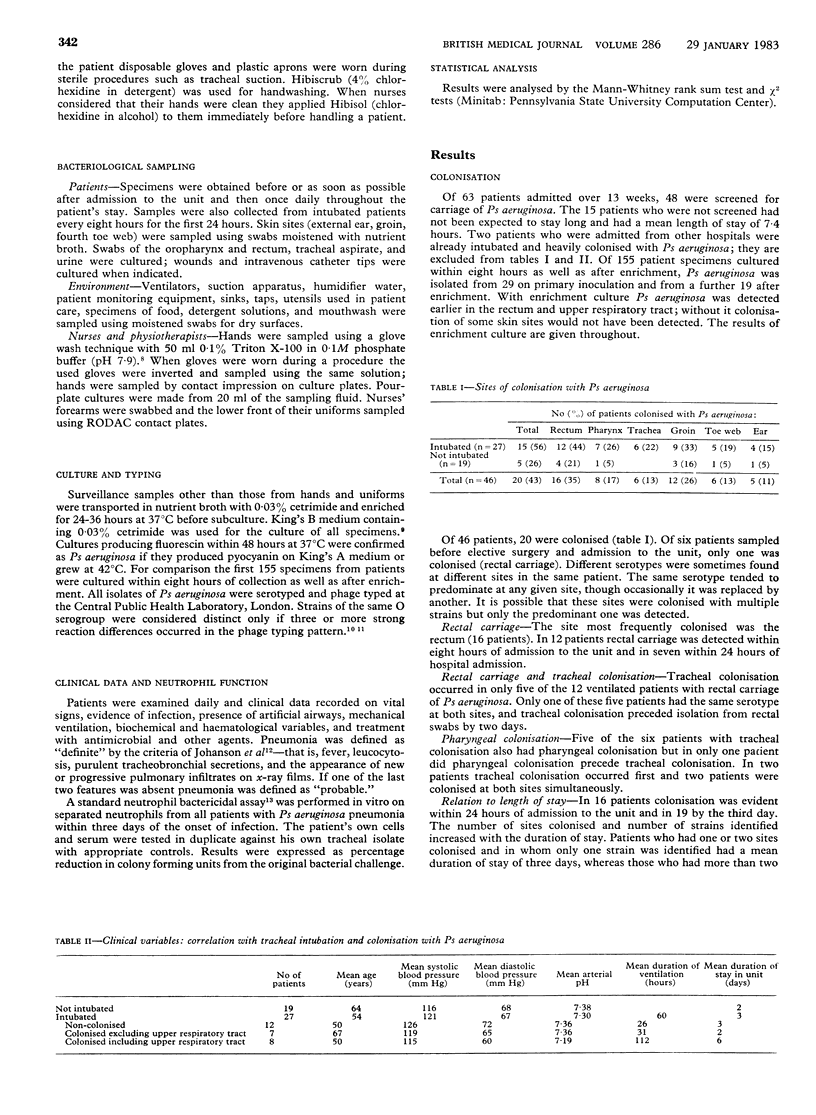Abstract
Despite the sparsity of Pseudomonas aeruginosa in the environment colonisation and infection with this organism was found at several sites by selective culture in 20 out of 46 patients in an intensive therapy unit. Three patients developed Ps aeruginosa pneumonia. Serial serogrouping and phage typing identified multiple strains in the unit and in the same patient. Rectal carriage occurred in 16 patients but rectal strains did not subsequently appear in tracheal aspirates; strains varied in their affinity for the upper respiratory tract. Colonisation was not directly related to length of stay and was detected in 16 of those colonised within 24 hours of admission. In intubated patients, who were colonised more frequently than those not intubated, upper respiratory tract colonisation correlated strongly with low initial arterial pH values. Personnel were probably responsible for cross infection among patients when the unit was busy. Strain differences and the susceptibility of patients also influenced colonisation and infection. Elimination of major reservoirs of Ps aeruginosa and compliance with procedures to control cross infection remain essential if patients in hospital are to escape colonisation by the organism.
Full text
PDF



Selected References
These references are in PubMed. This may not be the complete list of references from this article.
- AYLIFFE G. A., LOWBURY E. J., HAMILTON J. G., SMALL J. M., ASHESHOV E. A., PARKER M. T. HOSPITAL INFECTION WITH PSEUDOMONAS AERUGINOSA IN NEUROSURGERY. Lancet. 1965 Aug 21;2(7408):365–368. doi: 10.1016/s0140-6736(65)90343-0. [DOI] [PubMed] [Google Scholar]
- Albert R. K., Condie F. Hand-washing patterns in medical intensive-care units. N Engl J Med. 1981 Jun 11;304(24):1465–1466. doi: 10.1056/NEJM198106113042404. [DOI] [PubMed] [Google Scholar]
- Brown V. I., Lowbury E. J. Use of an improved cetrimide agar medium and other culture methods for Pseudomonas aeruginosa. J Clin Pathol. 1965 Nov;18(6):752–756. doi: 10.1136/jcp.18.6.752. [DOI] [PMC free article] [PubMed] [Google Scholar]
- Bryant L. R., Trinkle J. K., Mobin-Uddin K., Baker J., Griffen W. O., Jr Bacterial colonization profile with tracheal intubation and mechanical ventilation. Arch Surg. 1972 May;104(5):647–651. doi: 10.1001/archsurg.1972.04180050023006. [DOI] [PubMed] [Google Scholar]
- Goldstein E., Green G. M., Seamans C. The effect of acidosis on pulmonary bactericidal function. J Lab Clin Med. 1970 Jun;75(6):912–923. [PubMed] [Google Scholar]
- Johanson W. G., Jr, Pierce A. K., Sanford J. P., Thomas G. D. Nosocomial respiratory infections with gram-negative bacilli. The significance of colonization of the respiratory tract. Ann Intern Med. 1972 Nov;77(5):701–706. doi: 10.7326/0003-4819-77-5-701. [DOI] [PubMed] [Google Scholar]
- Johanson W. G., Pierce A. K., Sanford J. P. Changing pharyngeal bacterial flora of hospitalized patients. Emergence of gram-negative bacilli. N Engl J Med. 1969 Nov 20;281(21):1137–1140. doi: 10.1056/NEJM196911202812101. [DOI] [PubMed] [Google Scholar]
- Kohn J. A waste-trap-sterilising method. Lancet. 1970 Sep 12;2(7672):550–551. doi: 10.1016/s0140-6736(70)91351-6. [DOI] [PubMed] [Google Scholar]
- Lowbury E. J., Thom B. T., Lilly H. A., Babb J. R., Whittall K. Sources of infection with Pseudomonas aeruginosa in patients with tracheostomy. J Med Microbiol. 1970 Feb;3(1):39–56. doi: 10.1099/00222615-3-1-39. [DOI] [PubMed] [Google Scholar]
- Michaud R. N., McGrath M. B., Goss W. A. Improved experimental model for measuring skin degerming activity on the human hand. Antimicrob Agents Chemother. 1972 Jul;2(1):8–15. doi: 10.1128/aac.2.1.8. [DOI] [PMC free article] [PubMed] [Google Scholar]
- Phillips I., Spencer G. Pseudomonas aeruginosa cross-infection due to contaminated respiratory apparatus. Lancet. 1965 Dec 25;2(7426):1325–1327. doi: 10.1016/s0140-6736(65)92344-5. [DOI] [PubMed] [Google Scholar]
- Pitt T. L. A comparison of flagellar typing and phage typing as means of subdividing the O groups of Pseudomonas aeruginosa. J Med Microbiol. 1981 Aug;14(3):261–270. doi: 10.1099/00222615-14-3-261. [DOI] [PubMed] [Google Scholar]
- Quie P. G., White J. G., Holmes B., Good R. A. In vitro bactericidal capacity of human polymorphonuclear leukocytes: diminished activity in chronic granulomatous disease of childhood. J Clin Invest. 1967 Apr;46(4):668–679. doi: 10.1172/JCI105568. [DOI] [PMC free article] [PubMed] [Google Scholar]
- Stevens R. M., Teres D., Skillman J. J., Feingold D. S. Pneumonia in an intensive care unit. A 30-month experience. Arch Intern Med. 1974 Jul;134(1):106–111. [PubMed] [Google Scholar]


